New Mercedes GLB 250 fills curious niche
By John Gilbert
Deciding what vehicle to buy at a Mercedes-Benz dealership is a lot like making a menu selection at “Alice’s Restaurant” — Arlo Guthrie’s iconic song. The great line from the chorus — “You can get anything you want, at Alice’s Restaurant” — can be duplicated when looking over the delectable selections from Mercedes, which includes assorted tasty cars and SUVs.
The SUV world is running red-hot these days, and something like half of all SUVs fall into the compact or small segment. That had to make it tough for Mercedes, that proud company from Stuttgart, Germany, that invented the first automobile back before the 20th Century, and remains greatly responsible for what has become the crazy automotive world. After establishing its plateau for luxury and class, it was one thing to branch into the large SUV market, but quite different to build a compact utility vehicle.
But Mercedes has made the leap, and the 2020 GLB 250 is a remarkable example of what a company — a great company, at that — can do to command a slot in a segment that has to be out of its comfort zone.
Mercedes, of course, in its uncompromising way, creates an internal battle for supremacy with the GLB. There might be a question of how inexpensive can Mercedes make an SUV, or how expensive it dares make it. Same with its size, can a compact SUV house three rows of seats with the accommodations Mercedes is known for?
The GLB 250 checks all the boxes. With larger SUVs like the GLS and GLE out there, the company also turns out the GLC, which won Motor Trend’s SUV of the Year for 2017, so the intramural targets were in place and meant Mercedes engineers didn’t need to look outside for competition, although it is plentiful.
At a glance, the GLB has smooth lines but with more of a blunt look to it, snub-nosed and fairly tall, which allows a lot of interior ingredients. That includes a third-row of temporary seats, which will probably spend most of their career folded down into a flat and convenient floor for storage. The second row also folds down flat, while also sliding and reclining to add to the occupants’ comfort.
The 2.0-liter 4-cylinder engine performs well, and is part of a highly technical approach Mercedes has taken with the GLB. While other, larger Mercedes SUVs are built on a large-vehicle rear-drive platform, this one is built on a compact front-wheel-drive chassis, and the power of 221 horsepower and 258 foot-pounds of torque are applied via an 8-speed dual-clutch transmission, and the 4Matic all-wheel drive system operates normally through front-drive only, with the all-wheel-drive kicking in only when the system detects the tendency for the front wheels to spin.
You don’t feel all that mechanical operation, of course. It drives smoothly and its shifts are close to imperceptible, but right on, for keeping you in a proper power band.
Now we get to the price discrepancy. The test GLB 250 had a base price of $38,600, and it comes equipped with a lot of convenient features: the 4Matic, automatic stop-start, keyless start as well as entry, power lift-gate, rain-sensing wipers, Bluetooth with Apple CarPlay or Android Auto, LED head and tail lights, active assists for braking, antilock, electronic stability, rearview camera, black and red leather seats, Linden wood trim, and multi way power front buckets. You could own this vehicle for a long time with only those features and be a very happy traveler.
But now tell me which of the optional features you would gladly do without: Exclusive AMG sport steering wheel, panoramic roof, adjustable damping suspension, Burmester audio system, wireless charging, 20-inch black alloy wheels, a Driver Assistance package with active braking assist, cross-traffic Distronic X braking, emergency assisted steering, blind-spot assist, lane-changing alert, lane-keeping assist, and active assists for emergency stopping and steering. Other options include parking assist, exterior ambient lighting and a navigation map that updates itself for changing road conditions.
That’s nearly $20,000 worth of optional equipment, but all of it has great value in enhancing safety or comfort or convenience — even though it boosts the sticker price up to $57,800.
Adding to the enjoyment of driving the GLB 250, paddle shifters allow manual overriding of the 8-speed, and the suspension adjusts to comfortable firmness. Fuel economy is 23 miles per gallon city, 31 highway, and an average of 26 mpg. We found we got 28-32 even in city driving if we used the turbocharged power judiciously.
With its style and panache, the GLB will fit in well with its larger siblings in the Mercedes showroom, and more than most of the others, it can be bought as a “stripped down” economy SUV, or as a sporty-luxury SUV that you have to pay more to obtain. Maybe the best of both worlds, expanding the way you can get anything you want…at your closest Mercedes dealership.


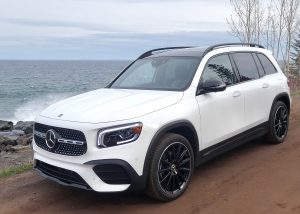
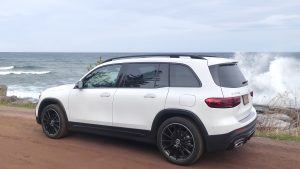
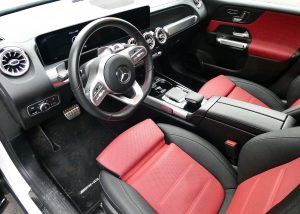
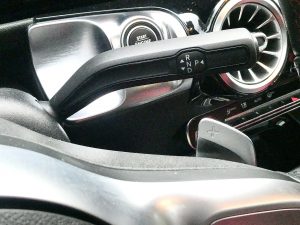
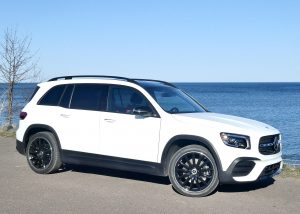
 John Gilbert is a lifetime Minnesotan and career journalist, specializing in cars and sports during and since spending 30 years at the Minneapolis Tribune, now the Star Tribune. More recently, he has continued translating the high-tech world of autos and sharing his passionate insights as a freelance writer/photographer/broadcaster. A member of the prestigious North American Car and Truck of the Year jury since 1993. John can be heard Monday-Friday from 9-11am on 610 KDAL(www.kdal610.com) on the "John Gilbert Show," and writes a column in the Duluth Reader.
John Gilbert is a lifetime Minnesotan and career journalist, specializing in cars and sports during and since spending 30 years at the Minneapolis Tribune, now the Star Tribune. More recently, he has continued translating the high-tech world of autos and sharing his passionate insights as a freelance writer/photographer/broadcaster. A member of the prestigious North American Car and Truck of the Year jury since 1993. John can be heard Monday-Friday from 9-11am on 610 KDAL(www.kdal610.com) on the "John Gilbert Show," and writes a column in the Duluth Reader.